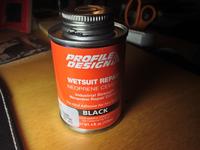 |
| Angelika/Mike Schilli |
|
Michael You might be aware of the fact that the Pacific ocean waters near San Francisco are so cold, that on average a few people drown close to the shore every year. Beach walkers are either caught by surprise by so-called "sleeper waves" (random unexpectedly big waves) and swept in, or they foolishly go in to rescue their swept-in pets. They don't realize that at 50 degrees Fahrenheit water temperature, muscles go stiff quickly, and unable to perform the required forceful strokes to overcome currents, even experienced swimmers can't make it back to shore.
But, as you might also know, even at my advanced age, I'm still trying to establish myself as a surfer, and only practicing during the yearly Hawaii vacation isn't going to cut it. That's why recently during a stay in the surfer paradise of Santa Cruz, I entered a local surf shop and purchased a really thick wetsuit that allows me to bear the local water temperatures.
What's not so obvious is that stepping into a wetsuit involves laborious physical work. This daunted on me when the surf shop salesman, after he had picked a suit for my size, and nudged me to the fitting room, casually said "Put it on, I'll check on you in 15 minutes". Modern wetsuits don't feature a zipper on the back anymore, it's simply that the neck opening at the top is astoundingly flexible and all you do is tear it apart really wide and step into the suit from above, feet first. Then, you employ superhuman strengths to pull it up, above your hips and chest, until only your head sticks out. As you can imagine, this can take time, until you get some practice.
Along with matching neoprene booties, gloves, and a rented surfboard, I tried out the cold Pacific waters near Pacifica recently and was surprised how pleasantly warm this felt while wearing the protective shell. I stayed in the water for about half an hour and didn't feel cold even for a minute. Truth be told, it turned out there was a small leak on the back side of the suit, which let in a few drops of icy water every once in a while, but I patched it up quickly at home with some newly aquired wetsuit cement glue (Figure 2). The black superglue gets applied thinly around the perimeters of the leak, and after waiting 10 minutes, you press the edges together with significant force, which creates a water-tight seal. It's no longer leaking now, and this better won't happen again, after all, the suit was expensive as hell!













